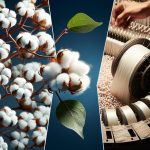Yes, I'd say Tencel is definitely long-lasting. It's tougher than it looks, resisting things like thinning, pilling, and fading pretty well. Even when you wash it, Tencel holds up better than a lot of other fabrics like cotton or rayon. It's also super soft and stays that way over time, which is a big plus. You do want to treat it right though—using gentle wash cycles and avoiding harsh detergents helps keep it in top shape. Overall, the durability of Tencel can save you some cash in the long run. Stick around, and you'll see just how versatile it really is!
Table of Contents
Key Takeaways
- Tencel fibers are strong and maintain integrity even when wet, enhancing their durability.
- Resistant to thinning, pilling, and fading, Tencel maintains its quality over time.
- Tencel outperforms cotton and rayon in durability, ensuring longer lifespan of products.
- Proper care, such as using mild detergents and avoiding high heat, further extends Tencel's longevity.
- Consumer feedback often highlights the material's resilience and ability to retain softness and color after multiple washes.
Understanding Tencel Fabric
Tencel fabric, recognized for its durability, is a top choice for those seeking long-lasting textiles. Here's why I'm all in when it comes to this fantastic fabric.
First off, Tencel's sustainable production is a major plus. It's made from renewable wood sources, which not only supports environmental sustainability but also contributes to the overall durability of the fabric. This means I'm getting quality material that's kind to the planet.
What I really appreciate about Tencel is how it holds up with regular use. Whether it's my go-to jeans or my comfy bed sheets, Tencel resists thinning, pilling, and fading, which is great because I want my stuff looking good for as long as possible. Plus, its resistance to deterioration during washing is a lifesaver. I can toss it into the machine without a worry, and it comes out looking as good as new. The maintenance is a breeze, and I don't have to be overly delicate with it.
All in all, Tencel's quality, combined with easy maintenance and strong resistance, makes it a reliable fabric that I trust for everyday wear and use. It's a win in my book for sustainability, durability, and overall value.
Tencel Durability Factors
Building on its stellar reputation, let's explore what makes Tencel so durable. The secret to Tencel's long-lasting nature starts at its very core—the fibers. Known for their strength, Tencel fibers are incredibly resilient, even when wet. This makes them less prone to damage during laundering, a common downfall for many other fabrics.
What's more, Tencel is resistant to common issues like thinning, pilling, and fading. This resistance helps maintain the fabric's integrity and appearance over time. For those of us who invest in Tencel bedding or clothing items, this means we're getting more bang for our buck. With proper care and maintenance, these pieces don't just last; they stay looking fresh and new longer than many other materials.
To give you a clear picture, let's look at a simple table that breaks down Tencel's durability factors:
| Feature | Benefit | Impact |
|---|---|---|
| Strong fibers | Less prone to damage | Longer-lasting wear |
| Resistance | Prevents thinning | Maintains shape |
| Color retention | Resists fading | Stays vibrant |
Tencel truly stands out as a reliable choice for anyone seeking durability in their textiles.
Tencel Vs. Other Fabrics
When comparing Tencel to other fabrics, it's clear that its durability really stands out.
It doesn't just last longer than cotton and rayon, but it also maintains its quality better through washes.
Plus, it feels great on the skin, which adds to its appeal as a top choice for both comfort and longevity.
Durability Comparison
Let's compare the durability of Tencel with other fabrics to see how it holds up. Here's what I've found:
- Strength When Wet: Tencel outshines cotton, maintaining its strength better when wet. This makes it especially robust for uses like bedding and clothing that frequently face moisture.
- Resistance to Wear and Tear: Due to its long-lasting fibers, Tencel resists wear and tear much better than many other fabrics. You won't see it thinning or pilling quickly.
- Maintains Quality: Tencel sheets are notable for keeping their quality over time, without showing early signs of wear.
- Overall Longevity: As a reliable choice for lasting comfort, Tencel's durable nature ensures it remains a staple in wardrobes and linen closets longer than many alternatives.
Comfort and Feel
Tencel's remarkably soft texture and luxurious feel set it apart from other fabrics in terms of comfort. What's more, the fine fibers of Tencel are kind to my skin, making it feel like I'm enveloped in a gentle hug. Its lasting softness isn't just a treat; it's a testament to its durability and enduring quality. Unlike many other materials, Tencel keeps its shape and texture, wash after wash.
Another standout feature is Tencel's moisture-wicking ability, which enhances its breathability. This keeps me cool and dry, especially during warm nights or busy days. With its resistance to pilling and fading, Tencel proves to be a reliable comfort choice for both my wardrobe and linen closet.
Maintenance and Care Tips
To keep your Tencel garments in top shape, it's crucial to follow a few maintenance tips.
I've found that using proper washing techniques, like setting the washer to a gentle cycle and using cold water, really helps maintain the fabric's integrity.
And when it comes to stains, treating them quickly and with the right products can make all the difference in preserving your Tencel items.
Proper Washing Techniques
How do you ensure your Tencel sheets last longer? It's all about following the right care instructions. Here's a simple guide:
- Use Gentle Water Cycles: Always wash your Tencel sheets in cold, gentle water cycles. This helps maintain their durability without stressing the fibers.
- Choose Mild Detergent: Opt for a mild detergent that's free from harsh chemicals. This prevents damage and keeps your sheets feeling soft.
- Avoid Harsh Chemicals: Never use bleach or fabric softeners on your Tencel sheets. These can break down the fibers and reduce their lifespan.
- Dry Properly: Air drying is ideal for Tencel. If you must use a dryer, select a low heat tumble drying option to minimize damage.
Effective Stain Removal
When dealing with stains on Tencel sheets, acting quickly is key to preventing permanent damage. The beauty of Tencel's durable and long-lasting nature is that with the right maintenance, you can ensure its quality for years.
Its strong fibers are notably resistant to thinning, pilling, and fading, which contributes significantly to its longevity. To effectively remove stains, dab the area gently with a mild detergent and cool water—never rub as this can damage the fibers. Rinse thoroughly and air dry to maintain the fabric's integrity.
Following these simple steps helps preserve the resistant qualities of Tencel, making it a reliable choice for long-term use without compromising its luxurious feel.
Common Uses of Tencel
Tencel is widely used in a variety of products due to its exceptional qualities. It's a standout material that balances softness with durability, making it a favorite in many industries. As someone who's deeply interested in sustainable and high-performance materials, I've noted how Tencel's versatility allows it to shine in several applications. Here's a quick rundown:
- Bedding: Tencel sheets are incredibly popular. They offer a soft, luxurious feel, similar to high-quality cotton, but are more sustainable and moisture-wicking. This makes them ideal for comfortable, breathable sleeping environments.
- Clothing: From flowy dresses to sharp shirts and durable activewear, Tencel fabrics are everywhere in the fashion industry. Its breathability and moisture-wicking properties keep you cool and dry, which is perfect for both leisure and intense physical activities.
- Home Textiles: Tencel is used in curtains and upholstery not just because it's durable and versatile, but also because it's eco-friendly. Its smooth texture and elegant drape add a touch of luxury to any home décor.
- Accessories: Lightweight scarves and gentle handkerchiefs are often made from Tencel. Its softness and gentle touch on the skin make it an excellent choice for items that are in direct contact with your skin all day.
Tencel Lifespan Expectancy
After exploring the various uses of Tencel, let's now focus on how long this material typically lasts. Tencel's reputation for durability isn't just talk; it's backed by the strong fibers that form its structure. This strength grants Tencel a longer lifespan compared to traditional cotton. When I think about making a lasting investment in my wardrobe or home, Tencel products are at the top of my list.
The secret behind Tencel's longevity isn't only its resistance to wear and tear but also how it's cared for. Following the right washing instructions is crucial. Proper care and maintenance keep Tencel items looking new and performing well for years. This includes using gentle detergents and avoiding high heat in washing and drying, which helps preserve both the softness and shape of Tencel fabrics.
What really impresses me about Tencel is its ability to retain softness and shape even after many washes. This aspect means you don't have to trade comfort for durability. By adhering to care guidelines, your Tencel pieces won't just last; they'll maintain their quality, making them a smart, sustainable choice for anyone looking to enhance their collection with long-lasting, reliable materials.
Environmental Impact
Considering its sustainable sourcing and production, the environmental impact of Tencel is significantly positive. It's clear that the fashion industry is recognizing the value of materials that not only last but also protect our planet.
Here's why Tencel stands out:
- Eco-Friendly Sourcing: Tencel fibers are harvested from certified wood sources. These are renewable resources which means they help keep our forests healthy and thriving.
- Reduced Environmental Burden: The production process of Tencel is more energy-efficient than that of traditional materials like cotton. It uses less energy and fewer chemicals, which means a lighter environmental footprint.
- Biodegradability: Once you're done with a Tencel product, it won't just sit in a landfill. Tencel is fully compostable and biodegradable. This promotes a cycle of sustainability that's hard to beat.
- Support for Sustainable Practices: By requiring less water and energy during production, Tencel supports sustainable practices in the fashion industry. This is crucial for reducing the overall impact our clothing has on the planet.
Consumer Reviews and Feedback
Many consumers have shared that they're impressed with how well Tencel holds up, especially in terms of durability and comfort over time. From the feedback I've read, it's clear that Tencel's resilience to wear and tear is a major selling point. Users often mention that their Tencel sheets or clothing items don't just last for a few months; they maintain their quality and softness for years. This certainly speaks volumes about Tencel's lasting quality.
Moreover, folks really appreciate how Tencel products handle washing. They report that even after multiple washes, the fabrics retain their color vibrancy and feel. This is great news for anyone like me who hates when their favorite shirt or sheets start looking faded and worn out too soon. It's reassuring to know that Tencel items can withstand regular laundry cycles without losing their appeal.
Future of Tencel Fabrics
Tencel fabrics are quickly becoming a game-changer in the fashion industry, thanks to their sustainability and growing popularity. As we look into the future, the potential for Tencel to dominate sustainable fashion is immense. With its lighter carbon footprint and impressive durability, there's a lot to be excited about.
Here's what I see shaping up for Tencel:
- Increased Production Facilities: Expanding Tencel production capacity is vital. It's currently a bit limited compared to cotton, but with more facilities, we could see a significant increase in availability and potentially lower prices, making it more accessible.
- Cost Accessibility: As production scales up, the cost of Tencel fabrics should become more competitive. This is crucial for widespread adoption in mainstream markets.
- Ethical Practices and Transparent Supply Chains: The push for ethical practices isn't just a trend; it's becoming a standard. Tencel is at the forefront, with brands investing in transparent supply chains that consumers can trust.
- Eco-friendly Properties and Durability: Tencel's low environmental impact and long-lasting nature make it a perfect candidate for anyone looking to support sustainable fashion without sacrificing quality.
Looking forward, the future outlook for Tencel in the fashion industry isn't only promising but could redefine textile standards globally.
Frequently Asked Questions
How Long Does TENCEL Fabric Last?
In my experience, Tencel fabric lasts quite a long time. It's strong, resists wear and tear, and with good care, it can keep its quality for years, making it a great sustainable option.
How Durable Is Tencel?
Tencel's durability impresses me; it withstands frequent washes and maintains its quality. It resists pilling, fading, and thinning, making it a top choice for everyday wear and long-term use.
What Is the Disadvantage of TENCEL Fabric?
The disadvantage of Tencel fabric is that it wrinkles easily, has limited color options, and requires careful, specific maintenance. Additionally, its higher cost can be off-putting, and it may shrink if not properly cared for.
Does TENCEL Last Longer Than Cotton?
I've found that Tencel does indeed last longer than cotton. It's more resistant to wear, less prone to pilling, and holds up better to repeated washings, making it a more durable option.
- What Is Modals and Explain Its Types? - April 21, 2024
- What Is the Rule of Modals? - April 21, 2024
- What Is the Main Function of Modals? - April 21, 2024







